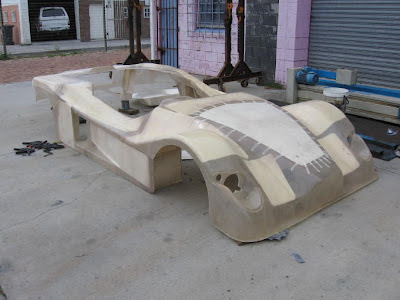However, just like you should never go and visit a restaurant kitchen before you eat there, the body work of a car looks a lot less appealing in its raw form. The moulds were duly prepped, layered and out popped the new body...all naked like!
All the while chassis work was going on at the factory. The way things work when you build a car like this is that you have to completely assemble the car, then completely strip it again so that you can treat the chassis and then you put it all back together again. It seems like a lot of extra work, but it's the only way to do things when developing a new model. You certainly don't want to be welding bits onto a newly treated chassis!
Parts started to arrive for the suspension, steering system, internal panelling and hubs. The car is based on mostly Toyota parts as they are easy to get hold of, relatively cheap and generally reliable. These hubs are from the RunX.
The fuel tank, being a squashy bag like thing, needed a box to hold it all together. The nice thing about having the fuel tank made like an aircraft tank is that you don't have to stick to geometric shapes. They can make pretty much any shape you want. We had a sort of L shape with a little notch at the bottom to clear the pedal linkages. The tank holds about 63 litres. Nice change from the 25 litres my Lotus had.
As more and more parts were added the car started to come together. Here the floor panels and centre console are being test fitted with the fuel tank in place. Everything needs to be checked over and over again. Gordon Murray is big on what are known as "engineering conflicts". This is when you bolt everything together and then discover you need to take the engine out to fill the oil because you put a chassis strut directly over the filler cap. The mark of a good design is to have minimal engineering conflicts. To find these conflicts components have to be fitted and tested over and over again, especially on a prototype such as this one.
Will the front suspension foul the radiator piping? Nope, the wonder of modern technology lets you design many of these moving parts in CAD and then actually "move" them in the software program to see what they might foul.
Here more panels are test fitted. These are the ones behind the driver. The battery is going to live back here as well as access to the alternator and belts so this need to be able to come off easily. Rivnuts are the best thing since sliced bread!






No comments:
Post a Comment